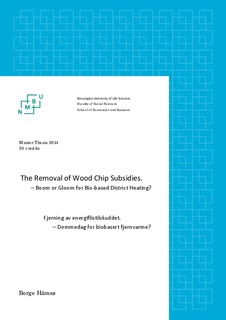| dc.contributor.author | Håmsø, Borge | |
| dc.date.accessioned | 2014-08-15T11:58:15Z | |
| dc.date.available | 2014-08-15T11:58:15Z | |
| dc.date.copyright | 2014 | |
| dc.date.issued | 2014-08-15 | |
| dc.identifier.uri | http://hdl.handle.net/11250/217349 | |
| dc.description.abstract | In this thesis I evaluate how the Norwegian Agriculture Authority’s (SLF) subsidy to forest wood chip production has affected district heating facilities’ profitability, and how the facilities will be affected by its removal in 2014. I evaluate the SLF subsidy by employing a theoretical investment model of a small and large district heating facility and model the removal of the subsidy through various scenarios. The analysis works under the assumption that district heating companies interpreted the subsidy as permanent and evaluates a worst-case and a best-case scenario for the removal of the subsidy. The small facility was particularly affected by the removal of the SLF subsidy with both scenarios yielding a negative net present value (NPV) on investment. For the large facility, only the worst-case scenario yielded a negative NPV. The analysis chapter demonstrates that the end of the SLF subsidy may have large impacts on district heating companies, particularly since many of the firms are still in a early stage of development and have thus far experienced relatively weak and variable financial results.
The thesis also demonstrates that the SLF subsidy’s narrow focus on a particular type of wood chip may have favored specific technologies; thus creating a recipe for suboptimal investments in the sector. This prompts a discussion of what constitutes prudent policy design for the bio-energy and district heating sectors. In this context I make some observations on the design of the SLF subsidy and how it measures up to relevant literature on policy design. My results indicate that it is likely the SLF subsidy was designed without the foresight and necessary caution needed to stimulate appropriate investment in both bio-energy production and district heating. | nb_NO |
| dc.language.iso | eng | nb_NO |
| dc.publisher | Norwegian University of Life Sciences, Ås | |
| dc.rights | Attribution 3.0 Norway | * |
| dc.rights.uri | http://creativecommons.org/licenses/by/3.0/no/ | * |
| dc.subject | VDP::Samfunnsvitenskap: 200::Økonomi: 210 | nb_NO |
| dc.subject | VDP::Teknologi: 500::Miljøteknologi: 610 | nb_NO |
| dc.title | The removal of wood chip subsidies : boom or gloom for bio-based district heating? | nb_NO |
| dc.title.alternative | Fjerning av energiflistilskuddet : dommedag for biobasert fjernvarme? | nb_NO |
| dc.type | Master thesis | nb_NO |
| dc.source.pagenumber | 73 | nb_NO |
| dc.description.localcode | M-ECON | nb_NO |

